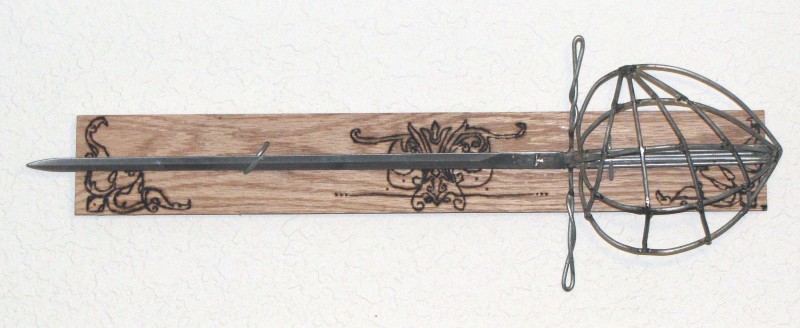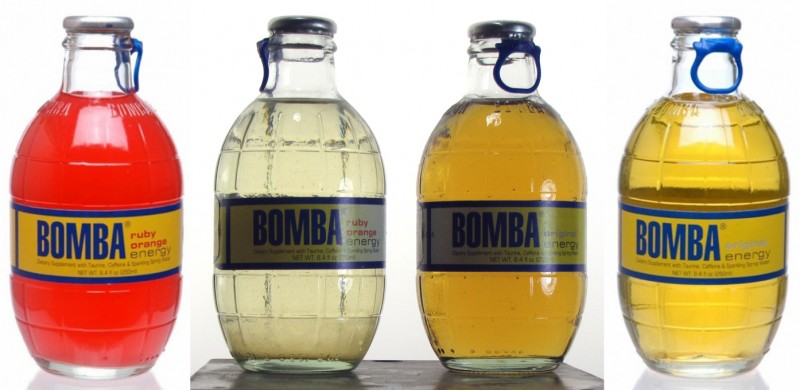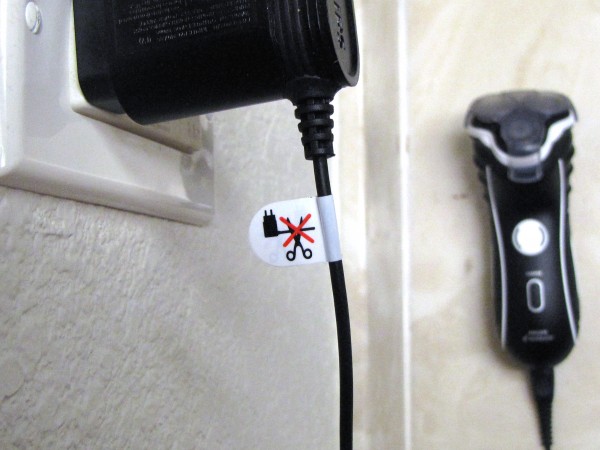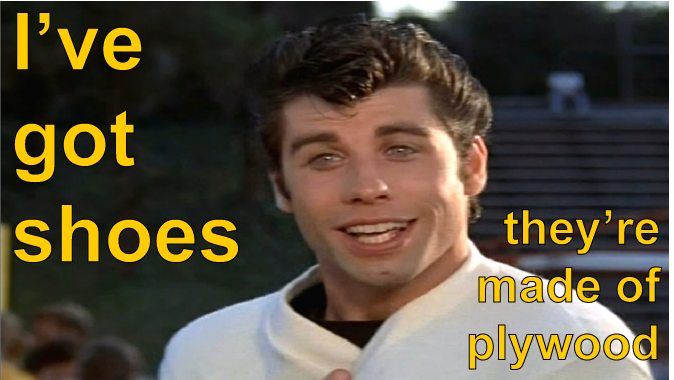
Monthly Archives: January 2012
Handmade gift from a young neighbor
In the house next door is a family of four—a married man and woman and their teenage son and daughter. I met the woman shortly after moving in, at the mailbox, and when she heard I worked for MAKE, she started talking about her son, who builds exotically-shaped Rubik’s cube-type twisting puzzles and sells them to enthusiasts around the world. I wrote a blog post about him shortly thereafter.
A few weeks later, while working outside of a morning, I heard a familiar sound over the fence in their backyard: a light metallic whang, repeating three times, with ten seconds or so between each, and then 30 or 45 before the group of three repeated. I knew the sound, but it took me a minute to reach back into memories of my own adolescence and place it: someone was practicing with throwing knives.
I stuck my head over the fence and said hello. The boy brought over his throwing knives—three of them, handmade from pieces of an old circular sawblade. I still have my own set (though mine were bought, rather than made) from when I was almost exactly the same age, doing almost exactly the same thing.
The boy and I struck up a friendship, and since that time he has rung my doorbell once or twice a week. And each time he brings over something he’s made, to show off. That, and questions: How would I make this? How would I find out about this? Where would I get this?
And the uncanny similarities between him and me, when I was his age, keep piling up.
I’ve taken lately to passing down some of my unfinished projects to him, some of my venerable and treasured junk. Around the beginning of December, I made a gift of two old blades left over when I dismantled a pair of cheap display swords, a few years back, to get at some decorative castings on their handles. He fit one of the blades with a full tang wooden handle and kept for himself. The other he fit with this elaborate guard and hand shield he welded up from steel wire. Then he mounted it on a piece of oak, decorated with his own pyrography, and presented it to me as a Xmas present.
The blade is a bit over two feet long, from pommel to tip, and the display board a bit under that. It’s probably not actually usable, but that is hardly the point. I hung it up on my office wall and intend to display it there, or someplace equally proud, for a very long time.
My enduring contribution to human culture
You’re welcome. Here’s a PDF virgin version.
Energy drink photobleaching
I wrote quite some time ago about my interest in grenade-shaped energy drink Bomba as a cultural artifact. I bought the inner two bottles, shown above, in early 2009. Each is displayed next to a promotional photo of the same flavor; to left, “ruby orange,” and to right, “original.” My bottles are dated “best before 05.22.09” and “best before 09.07.09,” respectively.
Part of the Bomba gimmick is the “pin” on the bottle cap, so I never opened the bottles in order to preserve the effect. I displayed them, over the intervening years, with other bottles and knick-knacks in a windowsill. “Ruby orange,” left, has been bleached almost water-white, I presume by sunlight. Since the drink is so far past its expiration date, it is, I suppose, possible that some kind of very slow solution-phase bleaching process is responsible. But evident photobleaching of the inks on the paper labels on the outside of the bottles (as well as notable bleaching of other dyed solutions displayed in the same windows) strongly suggests that photochemistry is the culprit.
“Ruby orange” lists FD&C Red #40 on the label, whereas the apparently unaffected color of “original” Bomba, to right, lists “artificial color (caramel color)” in place of the red dye.
An extremely useful label…
…on the charger for my new Norelco 7310XL. As near as I am able to interpret, it means, “do not cut this cord off.” The charger’s rated output is only 350 mA at 15V DC, which is scarcely hazardous; even if you were to cut the cord with uninsulated metal scissors, while it was plugged into mains power, the worst-case scenario is probably a noticeable tingle. Perhaps a cut, shorted cable could heat up and, eventually, somehow, cause a fire? If it were 1AM on Friday the 13th and you had just broken a mirror while chasing a black cat under a ladder in the process of killing an albatross?
Is it even a hazard warning at all?
I am now, in fact, almost so curious about the label’s purpose as to attempt exactly what it seems to forbid, just to see what happens. My charger will stop working—that much I’m quite sure of. But surely no one capable of operating an electric razor, in the first place, would be surprised at that outcome. What about all the other possible ways I could destroy the charger? If it needs a “do not cut off cord” label, doesn’t it also a need a “do not blast with a shotgun” label? Doesn’t everything else I own? “Hello, Norelco customer service? I vaporized my charger with a thermal lance and it stopped working. What gives? Shouldn’t there be a label or something?”
Galilean thermometer photobleaching
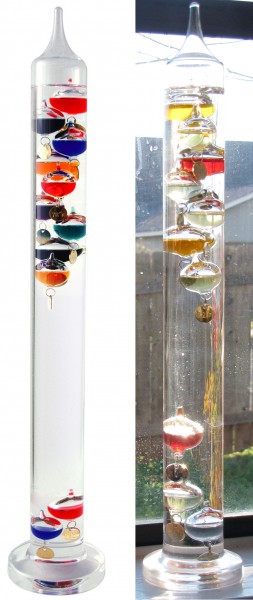 My brother bought me this Galileo thermometer (Wikipedia) as a Xmas gift in 2008. Out of the box, it looked very like the manufacturer photo shown at extreme left. The near-left picture was taken just today.
My brother bought me this Galileo thermometer (Wikipedia) as a Xmas gift in 2008. Out of the box, it looked very like the manufacturer photo shown at extreme left. The near-left picture was taken just today.
Over the intervening three years, it has been displayed continuously in one window or another, windowsills being not only useful locations to observe the temperature, but good places to show off the strikingly beautiful colors of the instrument. It was only a month ago that I noticed the blues and greens had faded away. I have noticed a similar effect in a pair of full bottles of Bomba energy drink that have also been kept in the sun (and for about the same length of time): the red is still red, while the blue has faded away. (Update: My memory of these bottles’ original colors was flawed. See this post.)
It’s likely the soda, at least, is dyed with Brilliant Blue FCF, aka Blue 1 (Wikipedia), and I wonder whether the Chinese-made Galileo thermometer also might have used the food-grade dye. It would be a sensible choice, for a manufacturer; with US consumption estimated at a million pounds a year, Blue 1 is dirt cheap, and obviously nontoxic, which the underwriters probably favor against the chance of an accident in which the thermometer breaks and the stuff gets into a human orifice or wound.

